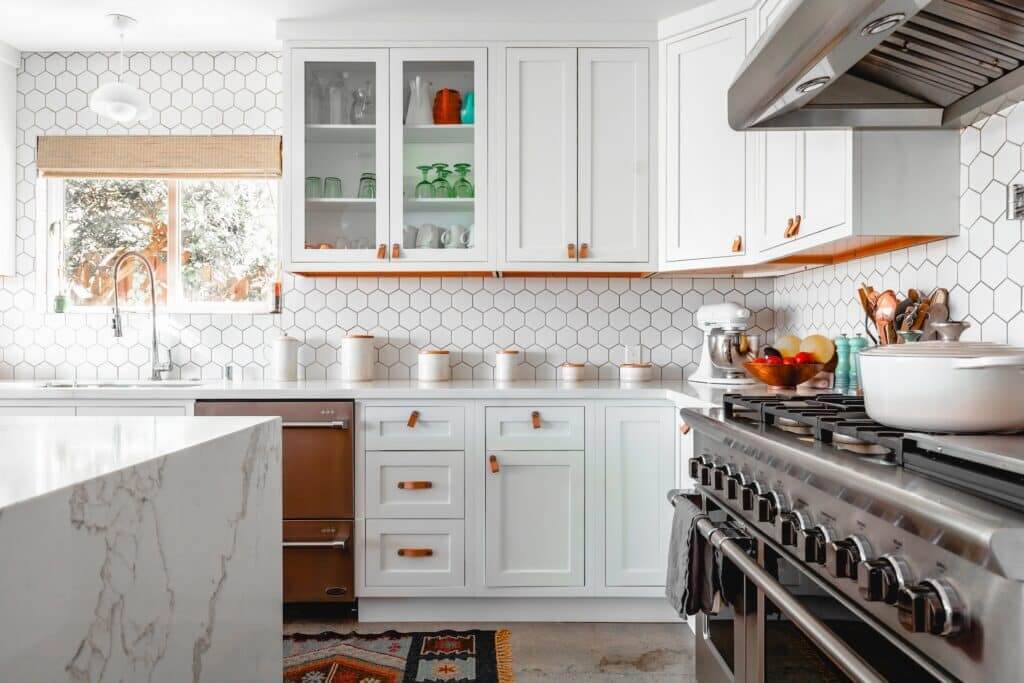Reminder: This checklist is a general guide and may need adjustments based on your specific needs, space, and preferences.
Embarking on a kitchen remodel is an exciting journey that promises not just a new look but an enhanced functionality for the heart of your home. To ensure a smooth and successful renovation, let’s dive into the ultimate Kitchen Remodel Checklist – your step-by-step guide to achieving the kitchen you’ve always dreamed of.
Kitchen Remodel Checklist:
1. Define Your Goals and Budget:
☐ List Priorities: Identify aspects like storage, functionality, aesthetics and any structural changes.
☐ Set a Budget: Break down costs for materials, labor, and unforeseen expenses.
2. Research and Inspiration:
☐ Gather Ideas: Explore design magazines, websites, and social media for diverse kitchen styles.
☐ Create a Mood Board: Compile images, color schemes, and textures for a visual representation of your vision.
3. Hire Professionals:
☐ Contractor: Research, interview, and hire a licensed and experienced contractor.
☐ Designer: Collaborate with a professional kitchen designer for layout and aesthetic expertise.
☐ Permits: Check local regulations and obtain necessary permits for construction and renovations.
4. Assessment and Measurements:
☐ Evaluate Space: Identify areas for improvement, note traffic flow, and assess natural light.
☐ Measurements: Accurately measure the kitchen space and note locations of electrical outlets and plumbing.
5. Layout and Design:
☐ Functional Zones: Plan cooking, prep, cleaning, and storage zones for efficiency.
☐ Appliance Placement: Finalize the placement of major appliances considering workflow.
☐ Cabinet Design: Choose cabinet styles, finishes, and hardware for both style and functionality.
☐ Island or Peninsula: Decide on the inclusion of an island or peninsula for added workspace or seating.
6. Material Selection:
☐ Countertops: Choose between materials like granite, quartz, or butcher block based on aesthetics and durability.
☐ Cabinetry: Select quality cabinets considering style, materials, and storage solutions.
☐ Flooring: Decide on flooring options that balance aesthetics, comfort, and maintenance.
7. Appliance and Fixture Selection:
☐ Appliances: Upgrade or replace appliances considering energy efficiency and technological features.
☐ Fixtures: Choose faucets, sinks, and lighting fixtures that complement the overall design.
8. Timeline and Scheduling:
☐ Set a Timeline: Collaborate with your contractor to establish a realistic project timeline.
☐ Scheduling: Coordinate phases like demolition, installation, plumbing, electrical, and finishing.
9. Temporary Kitchen Setup:
☐ Create a Temporary Kitchen: Set up a makeshift kitchen with essential appliances, cookware, and utensils.
☐ Stock Essentials: Ensure you have basic groceries and cooking essentials easily accessible.
10. Final Inspections and Touch-Ups:
☐ Final Walkthrough: Inspect the completed project with your contractor, noting any concerns.
☐ Touch-Ups: Ensure all finishing touches, including paint touch-ups and trim work, meet your expectations.
11. Post-Remodel Cleanup and Organization:
☐ Deep Cleaning: After construction dust settles, thoroughly clean all surfaces and appliances.
☐ Organization: Strategically organize kitchen items, maximizing storage efficiency.
12. Celebrate and Enjoy:
☐ Inaugural Meal: Prepare and enjoy a celebratory meal in your newly remodeled kitchen.
☐ Capture the Moment: Take photos of your new kitchen to commemorate the transformation.
By following this comprehensive Kitchen Remodel Checklist you’re not just renovating your kitchen – you’re creating a space that aligns with your lifestyle and culinary aspirations. Happy remodeling and may your kitchen be a source of joy and inspiration!
Kitchen Remodelling FAQ
Answer: Kitchen remodeling can enhance functionality, improve aesthetics, increase property value, and create a more enjoyable and efficient space for cooking and entertaining.
Answer: The cost of a kitchen remodel varies widely based on factors like location, size, materials, and scope of work. On average, a moderate remodel can range from $15,000 to $30,000, while a high-end remodel can exceed $60,000.
Answer: The timeline depends on the complexity of the project. A minor remodel might take a few weeks, while a major overhaul can extend to several months. Planning, design, and obtaining necessary permits also contribute to the timeline.
Answer: While some homeowners may opt for DIY projects, hiring a professional contractor is advisable for complex remodels. A contractor brings expertise, ensures code compliance, manages subcontractors, and helps navigate unforeseen challenges.
Answer: Determine your priorities, research costs for materials and labor, and add a contingency fund for unexpected expenses. Consulting with professionals can provide more accurate cost estimates.
Answer: Prioritize functionality, addressing structural issues, and creating efficient work zones. Consider upgrading appliances for energy efficiency, selecting durable materials, and optimizing storage.
Answer: Choose ENERGY STAR-rated appliances, install energy-efficient lighting, and consider well-insulated windows. Additionally, opt for eco-friendly materials and explore options for sustainable practices during construction.
Answer: Current trends include open shelving, smart appliances, minimalist design, mixed materials, and bold color choices. However, timeless designs that suit your personal style often have enduring appeal.
Answer: Consider custom cabinetry, pull-out shelves, and built-in organizers. Utilize vertical space with tall cabinets and explore creative storage solutions like hanging pot racks or a pantry organization system.
Answer: Permit requirements vary by location and the extent of the remodel. Generally, you may need permits for structural changes, electrical work, plumbing, and major renovations. Check with your local building department for specific requirements.
Answer: Set up a temporary kitchen with essential appliances, plan simple meals, and stock up on disposable plates and utensils. Consider using a microwave, slow cooker, or electric skillet for cooking.
Answer: Unforeseen structural issues, delays in material delivery, and unexpected expenses can pose challenges. Effective communication with your contractor, thorough planning, and a contingency fund can help mitigate these challenges.
Answer: While some tasks like painting or installing new cabinet hardware can be DIY-friendly, major remodels are best handled by professionals. DIY projects should be within your skill level, and you should consider safety and code compliance.
Answer: Invest in quality materials, hire reputable professionals, and perform regular maintenance. Follow manufacturer guidelines for appliances and fixtures, and address any issues promptly to prevent further damage.
Answer: Celebrate your new kitchen with a meal! Perform a final walkthrough with your contractor, address any outstanding issues, and keep all warranty information and maintenance guidelines in a readily accessible place.













